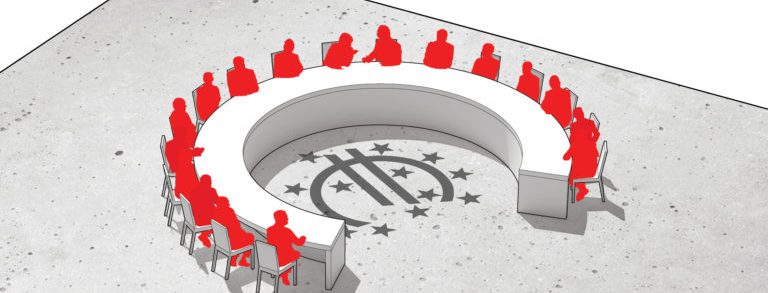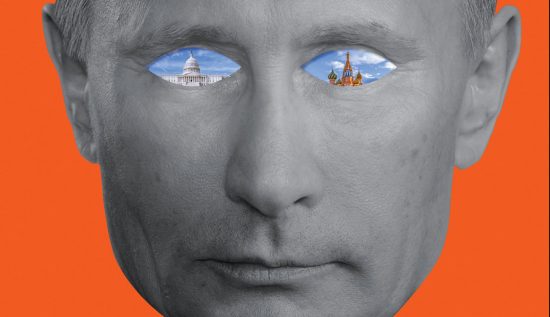“A day will come when all nations on our continent will form a European brotherhood […]. A day will come when we shall see […] the United States of America and the United States of Europe face to face, reaching out for each other across the seas.”
Just months before Victor Hugo’s speech at the International Peace Congress in Paris, the Communist Manifesto, written by Karl Marx and Friedrich Engels, was being published in London with the goal of spreading all around the world, inviting the workers to unite and fight to “lose [their] chains!” On the same continent, at the same time in history, we saw two groups wanting to unite with not so different goals: to live in peace. Despite the end being the same, the means would be the ones to start off what almost one hundred years later, with World War II concluded, would be called ‘the bipolar world’ – the capitalist United States and Western Europe against the communist Soviet Union and its allies.
One of the key allies and players in this bipolar world was Europe, especially the European Union (EU) later created. In it, capitalism has been, until today, the foundation and basis for the member countries’ economic and social interactions. On the other hand, the Marxist International Relations theory (MIRT), which will be later explained, born out of Marx’s and twentieth-century communist philosophers’ writings, with the aim of explaining the interactions between states, was conceived and born in this same geographical region, spread and extended throughout the world.
The aim of this essay is, indeed, to prove why the MIRT would negatively view the creation of the European Union, a sponsor of the capitalist interaction of states. To do this, this essay will be based on three arguments: first, historical materialism’s state’s unpredictable behavior makes the EU an unstable supranational organization, second, the ‘borderless’ Schengen area sustains the hegemonic inegalitarian capitalist economic system, and, third, the EU signifies the strengthening of the superstructure, one which does not represent the large base, the infrastructure composed by the working class – the proletariat –, but just the small and powerful bourgeoisie.
Main arguments
To understand the first argument, we must previously understand what historical materialism is. On one hand, materialism affirms that the world’s existence does not depend on human consciousness since it objectively exists in a material way. Thus, for historical materialism, in this material world, humans’ most basic and unconscious material interactions are based on the production of basic needs to survive. Only with these needs covered, which, when all the productive forces involved are combined, create the base, the superstructure, where social consciousness, reflected in law, spirituality, politics, art, etc., can exist. Even though the EU was created on the basis of the member states’ mutual agreement on, first, the 2004 European Constitution and, second, the 2009 Lisbon Treaty, the members act out of their own interest, their own survival. Unlike Realism, the MIRT does not understand interest as power, seen as a capitalist creation. The International Relations (IR) arena cannot be understood as an anarchic system since we would be implying “that states are autonomous agents whose rational behavior can be predicted. However, this ignores the endurance of regional inequalities and the structural and historical links between states, violence, and the key actors of the global political economy.”
We must not forget that the EU’s foundations only go back only a century ago when, first, the interwar period urged the continent’s economic integration and convergence with the flourishing and exponentially growing US market on the other side of the Atlantic. Indeed, it was in the 1920s when the British economist, John Maynard Keynes, created what we know today as ‘macroeconomics’ and, especially, Keynesian economics, the ruling economic policy that would reign over the world until the ‘70s. Among other things, he wrote that “a Free Trade Union should be established […] to impose no protectionist tariffs whatever against the produce of other members of the Union.” Second, in 1951, the European Coal and Steel Community (ECSC) was created. With the objective to centralize the industrial production regulations, six countries, ‘coincidentally’ the ones that benefited the most from the United States’ Marshall Plan, except the United Kingdom, it was first brought up by Robert Schuman, the French foreign minister in the first years of the ‘50s, just a couple of months before its creation, as a way to “make war not only unthinkable but materially impossible,” as he said in the famous Schuman Declaration. Thus, we can see that the very inception of this supranational organization was a result of both the economic and physical survival of the six winners of World War II, receivers of US money with the conditions, among others, to integrate into a common market and to follow the communist “containment policy.”
The idea of integration was fully developed over the next treaties that would be signed, adding on more European members. Six years, in 1957, the European Economic Community was created under the Treaties of Rome, with the aim of reducing the barriers to the movement of goods, services, labor, and capital, in addition to establishing a common external trade policy. This meant that the members of the now called European Community had to eliminate their national laws to establish the new supranational ones, especially the ones regarding internal tariffs and the ones that benefited national companies and industries. During the ‘70s and ’80 more countries joined, reaching the Maastricht Treaty in 1992, officially creating the European Union, with “three main pillars: the European Communities, the Common Foreign and Security Policy, and cooperation in the field of justice and home affairs.” A couple of years before the latter, the Schengen Agreement was signed in June 1985 with the objective of “removing borders, ensuring safety, and building trust.” The MIRT would definitely agree with the elimination of borders since they, in fact, create relations of dependency and, thus, inequality between people from different nationalities. Therefore, the EU would be, at first glance, creating real equal opportunities due to the lack of border controls.
However, the second argument can be backed by two strong pieces of evidence. First, even though people, goods, services, and capital can freely move, there still are countries with their own borders. Indeed, in each country, only its citizens get some benefits that foreigners do not. Furthermore, the EU acts like a ‘mega-country’ since it has a unique foreign and external policy. In the case of non-EU member countries’ citizens, they need a permit to work, for vacation, etc. Second, the EU’s economic system is based on the established ones, the hegemonic presence of the free market. Despite some countries having more or less government intervention, capitalism is present in all of them. Therefore, the Schengen Area is nothing more but a way to expand capitalism, to eliminate small national enterprises, substituting them for the big multinational companies that exercise great pressure and influence over countries’ policies. With this, inequality is further enhanced, not only between the non-EU, eastern communist, and non-capitalist societies but also among the capitalist member countries. This is due to two reasons. The first, the Marxist idea of historical materialism, explained earlier, assumes that “the material conditions can be changed by the actions of human beings.” This would, therefore, mean that the ideas and creations of man can shape man’s actions and thinking. Indeed, the creation of the European Union, a capitalist-based supranational organization, has created the basis for shaping and maintaining the capitalist status quo. And, second, Antonio Gramsci emphasizes that our social relations are dominated by capitalism since it is established and coerced through, for example, organizations like the European Union. Even more, it is not limited to the bourgeoise of the EU itself but, rather, the international capitalist class which imposes their interests all around the world through, especially, multinational companies.
The third argument, very closely related to the historical materialistic approach to the influence of material change, backs up the idea that the creation of the EU responds, directly, only to the needs and interests of the small bourgeoise class. The bureaucracy created in the EU’s organizations, the laws, and norms imposed in the member countries, create a structure similar to the superstructure explained in the first argument. Even though Marx sees the superstructure as a result of the base, it is also possible for the base to be influenced by the superstructure. Indeed, in this case, this superstructure does not respond to the real base’s needs, the proletariat, the working class. We must not think of the proletariat as people working in the factories of the Industrial Revolution. Instead, we must actualize the idea. Marx and Engels conclude that there has always been an oppressed class and an oppressor. From the Patricians and their slaves, to the feudal lords and the vassals, to the proletariat and the bourgeoise. Today, this working class is the low and middle-low class.

In this graph, from the OCDE April 2019’s report “Under Pressure: The Squeezed Middle Class,” we can see how, throughout the EU, the middle class has dramatically decreased, having a great impact on the lower class and, to a lesser extent, the upper class. This shows how the EU’s economic measures do, indeed, benefit only a few and damage the whole, the working class, that lower stratum of society that has carried Europe for centuries under the oppression of the small elite.
Conclusion
While the Communist Manifesto incites the workers of the world to unite and fight for a better, happier, and more equal world, the oligarchies of the capitalist bourgeoise class look only for their own benefit, justifying their means with the end. Indeed, we have proven in this brief analysis why and how, indeed, the MIRT sees the creation of the European Union with critical eyes.
As we have seen, three arguments can support this: (1) historical materialism’s state’s unpredictable behavior makes the EU an unstable supranational organization, based on historical materialism’s understanding of humans and states’ basic need to survive, (2) the ‘borderless’ Schengen area sustains the hegemonic inegalitarian capitalist economic system, based on the two ideas that, first, even though there is a free movement of people, goods, services, and capital, national frontiers still exist, and, second, the EU’s economic system is based on the hegemonic presence of the free market, strongly influenced by the capitalist American mindset, and, (3) the EU signifies the strengthening of the superstructure, one which does not represent the large base, the infrastructure composed by the working class – the proletariat –, but just the small and powerful bourgeoisie, proven with the latest results of the increasing low class and the decrease in the middle class.





